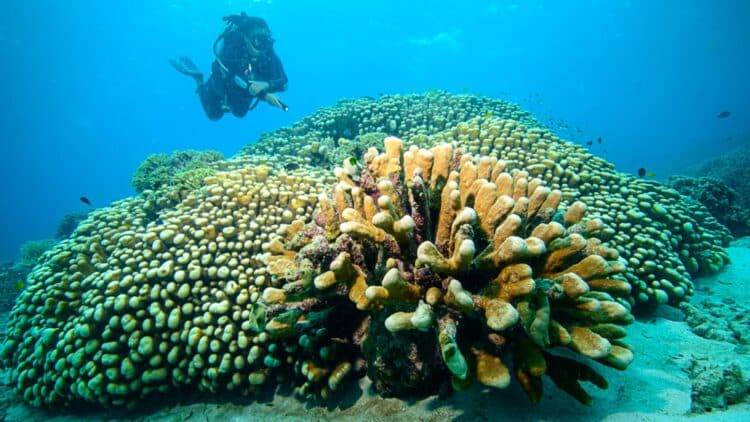An expedition for National Geographic’s Pristine Seas project led the Spanish explorer Manu San Felix to make one of the most important discoveries in the Solomon Islands. It occurred at a depth of 13 meters in the Pacific Ocean, where he recorded what so far has been the largest coral on the planet: a “Pavona claves,” measuring 34 meters wide, 32 meters long, and over five meters high. Estimates indicate that it could be around 500 years old, unlike typical coral reefs. It is a single living organism.
The most striking aspect has been its perfect condition. Scientists have determined that this is due to its location, at a depth where it has not been affected by the effects of global warming. According to one of the Pristine Seas scientists, Eric Brown, it does not even show signs of bleaching. For his part, the Climate Minister of the Solomon Islands, Trevor Manemahaga, has wanted to ensure that the coral is protected and not exploited, taking care of the marine biodiversity in which it lives and seeks refuge.
Underwater discovery in the Solomon Islands
One of National Geographic’s expeditions has triggered one of the greatest discoveries for the world of biology, especially marine biology. The discovery occurred while their Pristine Seas project was being carried out in the Pacific Ocean. There, in the Solomon Islands, a Spanish explorer, Manu San Felix, dove to a depth of 13 meters to uncover something unusual. Measuring 34 meters wide, 32 meters long, and over 5 meters high, a “Pavona clavus,” the largest coral on the planet, was recorded. Thanks to its size and the perfect conditions in which it has been preserved, experts have been able to determine that it is about 500 years old, and many have already dubbed it an “underwater cathedral”.
‘Pavona clavus’
Coral reefs are underwater structures that grow slowly over centuries and support one of the most diverse ecosystems on the planet, home to a wide variety of marine life, including fish, crustaceans, and mollusks. Their base is formed by corals, tiny animals resembling sea anemones, that live in colonies and secrete a hard external skeleton. They grow best in warm, shallow, clear, sunny, and moving waters. Unlike them, this new discovery is not a reef, but a coral in itself. It is a single, gigantic living organism that serves as a refuge and home for dozens of species, such as crabs, fish, or shrimp, among many others.
Global warming and marine biodiversity
Global warming has, as one of its consequences, the increase in ocean temperatures. This has been shown to have a direct impact on marine biodiversity, affecting its survival or forcing it to move in search of less hostile environments. However, this coral, which has even been mistaken for a giant rock, has proven to be a symbol in the face of the climate crisis the planet is experiencing.
According to one of the scientists from the Pristine Seas project, Eric Brown, “Although nearby reefs showed clear signs of degradation, this coral remained in perfect health, with no signs of bleaching.” The data obtained during the first dive were confirmed with a second dive, in which eight divers accurately measured the entire structure. This finding has been met with both joy and concern by Trevor Manemahaga, the Climate Minister of the Solomon Islands, as he has publicly emphasized the need to protect coral and prevent its deterioration: “Our coral is vital; we must ensure that it is not exploited”.
